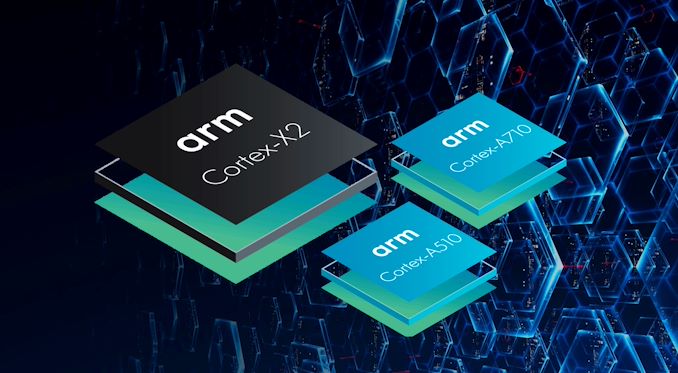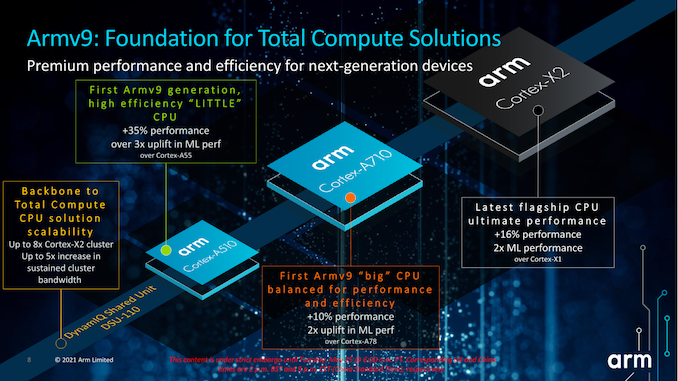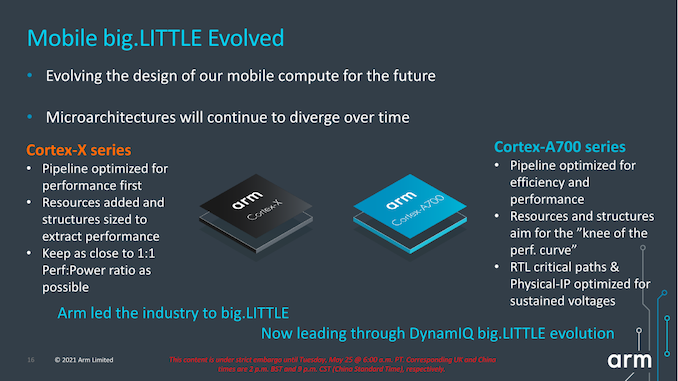Arm Announces Mobile Armv9 CPU Microarchitectures: Cortex-X2, Cortex-A710 & Cortex-A510
by Andrei Frumusanu on May 25, 2021 9:00 AM EST- Posted in
- SoCs
- CPUs
- Arm
- Smartphones
- Mobile
- Cortex
- ARMv9
- Cortex-X2
- Cortex-A710
- Cortex-A510

It’s that time of the year again, and after last month’s unveiling of Arm’s newest infrastructure Neoverse V1 and Neoverse N2 CPU IPs, it’s now time to cover the client and mobile side of things. This year, things Arm is shaking things up quite a bit more than usual as we’re seeing three new generation microarchitectures for mobile and client: The flagship Cortex-X2 core, a new A78 successor in the form of the Cortex-A710, and for the first time in years, a brand-new little core with the new Cortex-A510. The three new CPUs form a new trio of Armv9 compatible designs that aim to mark a larger architectural/ISA shift that comes very seldomly in the industry.
Alongside the new CPU cores, we’re also seeing a new L3 and cluster design with the DSU-110, and Arm is also making a big upgrade in its interconnect IP with the new cache coherent CI-700 mesh network and NI-700 network-on-chip IPs.
The Cortex-X2, A710 and A510 follow up on last year's X1, A78 and A55. For the new Cortex-X2 and A710 in particular, these are direct microarchitectural successors to their predecessors. These parts, while iterating on generational improvements in IPC and efficiency, also incorporate brand-new architectural features in the form of Armv9 and new extensions such as SVE2.
The Cortex-A510, Arm's new little core, is a larger microarchitectural jump, as it represents a new clean-sheet CPU design from Arm’s Cambridge CPU design team. A510 brings large IPC improvements while still having a continued focus on power efficiency, and, perhaps most interestingly, retains its characteristic in-order microarchitectural.
An Armv9 CPU Family – AArch64 only for all practical purposes*
The new CPU family marks one of the largest architectural jumps we’ve had in years, as the company is now baselining all three new CPU IPs on Armv9.0. We've extensively covered the details of the new Arm architecture back in late March. Cornerstone features of the new ISA include the new enrollment of prior optional/missing Armv8.2+ features that weren’t guaranteed in mobile and client designs (mostly due to the older A55 cores), and the introduction of new SVE2 SIMD and vector extensions.
One big change we’ve been expecting for quite some time now is that we’ll be seeing a deprecation of the 32-bit AArch32 execution mode in upcoming Arm Cortex-A mobile cores. The clock has been ticking for 32-bit apps ever since Google’s announced in 2019 that the Google Play store will require for 64-bit app uploads, and the company will stop serving 32-bit applications to 64-bit compatible devices later this summer
While Arm is declaring that shift to happen in 2023, for all intents and purposes it’s already happening next year for most global users. Both the Cortex-X2 flagship core and the Cortex-A510 little cores are AArch64-only microarchitectures that are no longer able to execute AArch32 code.
With that said, sharp readers will note that two out of three CPUs isn't a complete shift, and the reason for that is because the Cortex-A710 actually still supports AArch32. Arm states that the reason for this is primarily to meet the needs of the Chinese mobile market, which lacks the homogeneous ecosystem capabilities of the global Play Store markets, and Chinese vendors and their domestic app market require a little more time to facilitate the shift towards 64-bit only. This means we’ll have an odd scenario next year of having SoCs on which only the middle cores are able to execute 32-bit applications, with those apps being relegated to the middle A710 cores and missing out on the little A510 cores’ power efficiency or the X2 cores’ performance.
On the big core side, the new Cortex-X2 and Cortex-A710 are successors to the Cortex-X1 and Cortex-A78. Both designs are mostly designed by Arm’s Austin design team, and represent the 4th generation of this microarchitecture family, which had started off with the Cortex-A76 several years ago. These cores should be the last of this microarchitecture family before Arm hands things off to a completely new design with next year’s new Sophia cores.
In terms of design philosophy, the X2 and A710 generally keep the same overarching goals the X1 and A78 had defined: The X-series continues to focus on advancing performance by increasing microarchitectural structures and by Arm being willing to make compromises on power within reasonable limits. Meanwhile the A710 continues to focus on advancing performance and efficiency through smarter design and with a large focus on maximizing the power, performance, and area (PPA) balance of the IP.
One point Arm makes in the above slide is having optimized critical paths and physical design for sustained voltage operations – this is more of a goal the company is striving for in the next generations of “middle” cores rather than something that’s specifically reflected in the Cortex-A710.
This year, we are also finally seeing a new little core. We had covered the Cortex-A55 back in 2017, and since then we haven’t had seen any updates to Arm’s little cores, to the point of it being seen as large weakness of last few generations of mobile SoCs.
The new Cortex-A510 is a clean-sheet design from Arm’s Cambridge design team, leveraging a lot of the technologies that had been employed in the company’s larger cores, but implemented into a new in-order little microarchitecture. Yes – we’re still talking about an in-order core, and Arm still sees this to be the best choice in terms of extracting the best efficiency and “Days of use” of mobile devices.
Even though it’s a in-order core, Arm made a comparison that the new design is extremely similar to a flagship core of 2017 – namely the Cortex-A73, achieving very similar IPC and frequency capabilities whilst consuming a lot less power.
The new design also comes with a very interesting shared complex approach and shares the L2 and FP/SIMD pipelines with a second core, a design approach Arm calls “merged core” and undoubtedly will remind readers of AMD’s CMT approach in Bulldozer cores 10 years ago, even though there are quite important differences in the approaches.














181 Comments
View All Comments
mode_13h - Wednesday, May 26, 2021 - link
> Android needs to get their developers to stop using Java and use C/C++/Rust for their apps to eek out the max performance possible.No, I'm sure Google would rather they use Go.
Also, unless you compile your C++ to web asm, it has the disadvantage of leaving out users on newer devices not supported by the NDK version where you built your app. Like RISC V, for instance. Interpreted languages and those that compile into a portable intermediate representation don't have this problem.
> it's a long time nagging issue that I wish the Android community would solve.
Your best hope is that Web Assembly takes over, then.
hlovatt - Thursday, May 27, 2021 - link
> Android needs to get their developers to stop using Java and use C/C++/Rust for their apps to eek out the max performance possible.> Apple's App code base is generally C/C++, that's why they have the performance
Apple code is mainly Objective-C and Swift (neither are particularly fast).
> https://benchmarksgame-team.pages.debian.net/bench...
These benchmarks are largely discredited because they include the start up time in the measurements, which unrealistically hampers virtual machines as used by Java. Its like opening your mailer, typing a couple of characters, and then shutting down your mailer, opening your mailer again, another couple of characters, repeat. Then saying you mailer is slow. Most apps are long running and counting the opening and closing down of the virtual machine for a small task doesn't give useful results.
mode_13h - Wednesday, May 26, 2021 - link
> Apple is in a very very special situation where they control everything. Hardware,> software, product. Plus they use the best process there is at the moment.
> All of this, contributes to their results. Which are very good, but they stem from
> what I told you.
They get a benefit from using the latest process, but that doesn't help them relative to anyone else on that same process node. ARM probably does as much work or more to port their IP to a process node & libraries as Apple does.
They *do* get a benefit from controlling the OS. I'll grant you that. The main thing that can probably help is dialing in clockspeed & thermal management, as well as how load-balancing with the low-power cores is managed.
However, the rest of it is irrelevant for SPEC scores, because the Anandtech team uses the same compilers and the SPEC source is also the same.
> Their cores are not exactly suited for the plethora of android devices that range from 50 bucks to 2000+.
Well, the upper end of that range, yes. That's the biggest thing Apple has in their favor: bigger budgets for bigger cores on newer nodes.
> ARM cpus lose compatibility totally once in a while, which is not something that will work in the long run.
Seems like little-to-no burden for ARMv9 CPUs to retain ARMv8 compatibility, though. When they go to ARMv10, that might be a different story.
> Intel hasn't introduced anything major since 2015!
If Sunny Cove doesn't count as something new, then I think your standards are unrealistic.
BTW, if you want bigger micro-architectural changes, try Gracemont.
Silma - Tuesday, May 25, 2021 - link
Apple & ARM benefit from the best foundries in the world, which has not been the case for Intel for at least 3 years.If Intel catches up in production tech or gets access to the same process than Apple and Co, we'll see who has the better designs for which workloads.
melgross - Tuesday, May 25, 2021 - link
I do think that Intel’s designs are better than AMD designs. They’re not that much s,owner, when they are, and and is on a smaller, faster node. But as far as Apple’s designs, I doubt it. The designs are too different to make that claim. Additionally, and SoC is far more than just CPU cores. That just a fifth of Apple’s SoC.igor velky - Tuesday, May 25, 2021 - link
AMD didnt invent multichip modules, those are lies !IBM had servers with multichip cpus in like 1985ish
Intel Core2 had some cpus which were MCM, too.
ten or so years ago.
mode_13h - Wednesday, May 26, 2021 - link
> Intel Core2 had some cpus which were MCMThe Pentium Pro had its L2 cache on a separate die.
kgardas - Tuesday, May 25, 2021 - link
x86 is dead? Well, it is, welcome amd64.Anyway, I would not consider latest Zen or Sunny Cove/Willow Cove cores as non-competitive even with the latest Apple Mx designs. IMHO they are doing fine. Now, do you know that Alder Lake/Sapphire Rappids will have Golden Cove? And that should arrive this and early next year probably. The core should again provide quite nice bump in IPC. So both ARM and even Apple will have again more than adequate competition. No, neither intel nor amd are dead. Pretty exciting times ahead...
GeoffreyA - Tuesday, May 25, 2021 - link
Oh boy, here we go again. x86, dead. Apple M1, enchanted stuff. Intel/AMD, rubbish for the dump. All hail, Apple!Silver5urfer - Wednesday, May 26, 2021 - link
Logically their tunnel vision has only 2 possible reasonsOne - Apple hardcore fans and somehow their daily tasks and lives rely only on Mac OS or iOS, ignorant on the reality and dumb to believe SPEC and Apple marketing PR.
Two - They hate Intel a lot and also PC platform a lot, have a console probably and a Macbook BGA junk.
I do not know what else and why would anyone hate x86 processors from Intel and AMD, I do not see any point since they are the PCs we can own today and they will last literally for decades. People are using old school Xeon for home server and old school pre SSE4.2, basically Phenom II and Intel Core 2 Quad Q6600 Processors to play damn latest games with community patches for .exes, then we have the latest HW for PC in HEDT and Mainstream for multiple use cases.
Why would anyone hate the only processing standard which has excellent backwards compat full blown parts system for DIY and repair etc, and literally choice of your own OS - Linux, Windows and some Intel HW for Hackintosh. Yep they are dumb and ignorant for sure.